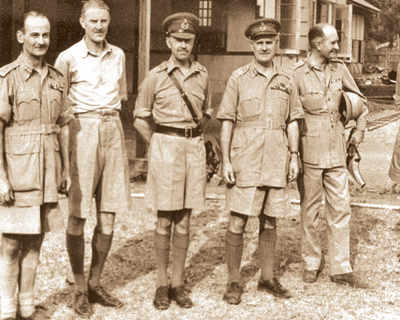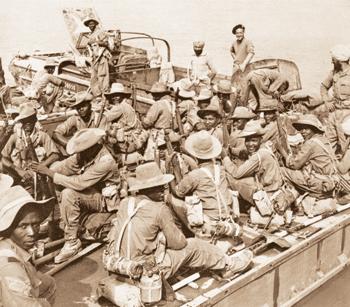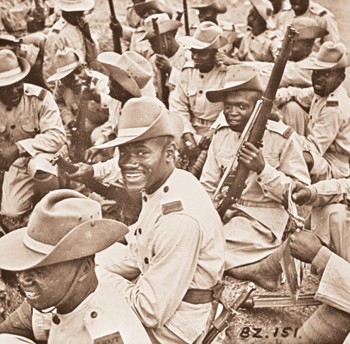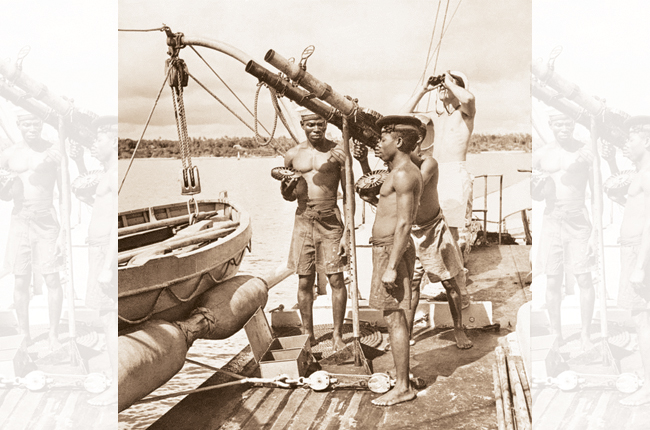Ceylon was a strategic hub for the Allied Forces from 1939 to 1946. Senior citizens from the ‘Ceylon’ vintage recall memories of robust African soldiers who served this island during the Second World War. The Ceylonese referred to these African combat troops as ‘Askari’ , a term already popular in the British Empire. Across the country we can still see Sri Lankans whose lineage can be traced to African soldiers who served here. In today’s narrative we focus on why the Allied Command selected Ceylon as a training area for its dependable and feared African commandos.

British Commanders in Burma.
Old wartime records indicate that at one time there were between 500- 5,000 elite African combat troops stationed in Anuradhapura and Kandy areas. Today their immense contribution is forgotten. In addition, Ceylon Light Infantry troop detachments were stationed in Kandy in defence of the Supreme Commander Admiral Mountbatten.
The Burma campaign was a series of battles fought in the British colony of Burma. It was part of the South-East Asian theatre of World War II and involved Allied Forces against the invading forces of the Empire of Japan. The Japanese bombed Rangoon on December 23, 1941. The Burma Campaign was the longest land campaign fought by the British in WWII. As the fighting in Burma raged, American and Australian Forces were engaged against the Japanese in New Guinea.
The geographical characteristics of Burma meant that weather, disease and terrain had a major effect on operations. The lack of transport infrastructure placed an emphasis on military engineering and air transport to move and supply troops, evacuate wounded soldiers. Majority of the African troops were selected to fight in the dangerous forests of Burma, and prior to their deployment were sent to tropical Ceylon to train and augment their jungle warfare tactics. The British and American troops found it difficult to adjust to tropical forest conditions. The Japanese were thoroughly prepared, determined and used the jungle effectively. Their infantry soldiers used bicycles to quickly advance. The Japanese deployed their tanks, which the British had thought impractical within the dense jungle.
Deployment in Ceylon
In August 1943, the Allied Forces Command created South East Asia Command (SEAC), responsible for the South-East Asian Theatre, under Admiral Louis Mountbatten. The Ceylon Defence Force (CDF) was already active and defended our nation with courage and dedication. The Ceylon Regiment composing of Malays, Ceylonese and persons of African origin was active by the 1870s. In 1910, the Volunteer Corps was re-designated as the Ceylon Defence Force. From 1897 through 1949, the Army Service Corps took over the commissariat and logistics functions of the British Garrison.
The 11th (East Africa) Infantry Division was formed in February 1943 during the Second World War. The Division was composed of troops from Kenya, Uganda, Nyasaland, Tanganyika, Rhodesia and the Belgian Congo. The 11th (East Africa) Division fought with the Fourteenth Army in Burma during the Burma Campaign. In the later part of 1944, the division pursued the Japanese retreating from Imphal down the Kabaw valley and established bridgeheads over the Chindwin River. The conscripted soldiers from British East Africa were known as the King’s African Rifles.

Soldiers enroute to Burma.
It was not until May 1943 that the divisional headquarters assumed control of all its units, except for the 21 Infantry Brigade Group, which had left East Africa and was based in Ceylon. The rest of the division arrived in Ceylon in June 1943. It came under Ceylon Army Command on June 28, 1943. On May 31, 1944, it came under command of Headquarters, South East Asia Command (SEAC). Ceylon Army Command sanctioned the division’s new badge on August 23, 1943- it was a red patch with a black Rhino.
Triumph and tragedy are part of any war. The 3rd Field Regiment in the division was the 301 Field Regiment, comprising the Independent East Africa Field Battery, 57 and 62 Field Batteries. However, the ship on which most of the regiment was on board en-route to Ceylon (the HMT Khedive Ismail) was sunk by a stealthy torpedo from a Japanese submarine in February 1944. The regiment lost most of its personnel in this unexpected attack. For the African Division it was a warning lesson for future sea movements.
Jungle Warfare – WW2
Suffocating heat, tropical rain and hostile jungle terrain are the treacherous obstacles that confronted the Allies when they fought against the Imperial Japanese Army in the Southeast Asian forests. In jungle warfare, the soldier fights two enemies: man and nature. The jungle was a harsh terrain for fighting where Malaria killed more men than the enemy during WW2. The British relied heavily on Indian, Gurkha and African soldiers. African regiments often worked in tandem with the British Indian Army units known as ‘Chindits’. They were the pioneer Long Range Penetration Force during WW2. By engaging enemy units and interrupting supply lines, they prevented the Japanese deploying all their resources to the main battle zones in Burma.
Another challenge facing soldiers fighting in the jungles was that of issuing and receiving orders. Steep slopes, few accessible tracks, thick jungle and muddy treacherous streams did much to hinder troop communication. Severe weather also has an impact on tactical operations in the jungle. Movement in the mangrove swamps was mostly restricted to foot (sometimes small boats). Vehicular traffic was impossible. Mosquitoes, centipedes, scorpions, wasps, bees, snakes and leeches had to be endured in the dense forests. The Africans trained in the jungles of Ceylon.
These pioneer African Jungle Warfare Platoons were the first forces to be fully supplied by air drops in this region of WW2 combat. We can assume that Royal Air Force pilots stationed in Ceylon did precision practice drops within our own jungles, preparing for the assault on Burma.
Operation Dracula
Operation Dracula was a World War 2-airborne and amphibious attack on Rangoon by British and Anglo-Indian Forces during the Burma Campaign. It was vital to capture Rangoon before the start of the monsoon to secure the lines of communication of the Allied troops in Burma. Under the modified plan for Operation Dracula, the Indian 26th Division would establish beachheads on both banks of the Rangoon River. The British 2nd Division would follow up through these beachheads several days later to launch the main assault on the city.

Armed and ready.
During April 1945, units of the British Fourteenth Army advanced to within 40 miles (64 km) of Rangoon. On the same day a gallant Gurkha parachute battalion landed on Elephant Point at the mouth of the Rangoon River. Early on May 1, eight squadrons of B-24 Liberator and four squadrons of B-25 Mitchells, and two squadrons of P-51 Mustangs from the 2nd Air Commando Group United States Army Air Forces (USAAF) bombed and strafed Japanese defences South of Rangoon.
After fierce fighting, Meiktila and Mandalay were captured in March 1945. It was a decisive victory, won through the courage and endurance of the troops and the leadership of their Commander William Slim. Field Marshal William Slim is best known for commanding Fourteenth Army in Burma. He inherited a disastrous situation which, with pragmatic skill he turned to ultimate victory.
Life in Ceylon
The arrival of the 11 East Africa Division in Ceylon and the role of CASC (Ceylon Army Service Corps) in provisioning this division was a new challenge which the CASC did with diligence. To meet the exigencies of provisioning troops, CASC established three farms: a vegetable farm in Nuwara Eliya, a goat farm in Kurunegala, and a cattle farm in Colombo. Wherever the Africans went the rural Ceylonese would be mesmerized by their stamina and robust appearance. On a recent visit to Kandy I went to Kundasale, where an Allied Forces camp was situated and hundreds of African troops were stationed. The Commonwealth War Cemetery at Kandy has a few graves with the names of departed African troops.
The British Empire’s military success in the Burma Campaign, and the East African Campaign, would not have happened without African soldiers. African soldiers participated heavily in the Burma Campaign in the Pacific theatre against Japanese Forces. This article is dedicated to the thousands of African troops who bravely fought and defended Ceylon. We salute their sacrifice.
By Dishan Joseph






